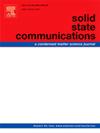Effects of point defect and surface polarity on the magnetism of undoped ZnO
IF 2.4
4区 物理与天体物理
Q3 PHYSICS, CONDENSED MATTER
引用次数: 0
Abstract
The effects of ZnO surfaces with different orientations and point defects on magnetism remains not fully understood, and it is experimentally difficult to control the growth orientation and point vacancies in ZnO. Therefore, to investigate the magnetism source of undoped ZnO, first-principles calculations were conducted on ZnO (), (), and () surfaces, both with and without defects, including oxygen or zinc vacancies (VO or VZn). Results revealed that the nonpolar () surface exhibited ferromagnetism in the presence of VZn, originating from the exchange interaction between unpaired O-2p electrons induced by VZn. The polar surfaces () and () were ferromagnetic both without vacancies and with VZn, the magnetism was caused by the spin polarization of unpaired electrons in the dangling bonds of surface atoms. The Zn-4s electrons originating from VO can pair with unpaired electrons in the dangling bonds, thereby reducing the magnetism of the polar surface. These findings contribute to a better understanding of the ferromagnetism induced by point defect and surface polarity in undoped ZnO, offering a theoretical foundation for its application in spintronic devices.
点缺陷和表面极性对未掺杂ZnO磁性的影响
具有不同取向和点缺陷的ZnO表面对磁性的影响尚不完全清楚,并且在实验上难以控制ZnO中的生长取向和点空位。因此,为了研究未掺杂ZnO的磁性来源,对ZnO(101 - 0),(101 - 2)和(101 - 1)表面进行了第一性原理计算,包括氧或锌空位(VO或VZn)。结果表明,在VZn存在下,非极性(101 - 0)表面表现出铁磁性,这是由VZn诱导的未配对O-2p电子之间的交换作用引起的。极性表面(101 - 1)和(101 - 2)是铁磁性的,既没有空缺,又有VZn,磁性是由表面原子悬空键中未配对电子的自旋极化引起的。来自VO的Zn-4s电子可以在悬空键中与未配对的电子配对,从而降低极性表面的磁性。这些发现有助于更好地理解未掺杂ZnO的点缺陷和表面极性引起的铁磁性,为其在自旋电子器件中的应用提供了理论基础。
本文章由计算机程序翻译,如有差异,请以英文原文为准。
求助全文
约1分钟内获得全文
求助全文
来源期刊

Solid State Communications
物理-物理:凝聚态物理
CiteScore
3.40
自引率
4.80%
发文量
287
审稿时长
51 days
期刊介绍:
Solid State Communications is an international medium for the publication of short communications and original research articles on significant developments in condensed matter science, giving scientists immediate access to important, recently completed work. The journal publishes original experimental and theoretical research on the physical and chemical properties of solids and other condensed systems and also on their preparation. The submission of manuscripts reporting research on the basic physics of materials science and devices, as well as of state-of-the-art microstructures and nanostructures, is encouraged.
A coherent quantitative treatment emphasizing new physics is expected rather than a simple accumulation of experimental data. Consistent with these aims, the short communications should be kept concise and short, usually not longer than six printed pages. The number of figures and tables should also be kept to a minimum. Solid State Communications now also welcomes original research articles without length restrictions.
The Fast-Track section of Solid State Communications is the venue for very rapid publication of short communications on significant developments in condensed matter science. The goal is to offer the broad condensed matter community quick and immediate access to publish recently completed papers in research areas that are rapidly evolving and in which there are developments with great potential impact.
 求助内容:
求助内容: 应助结果提醒方式:
应助结果提醒方式:


